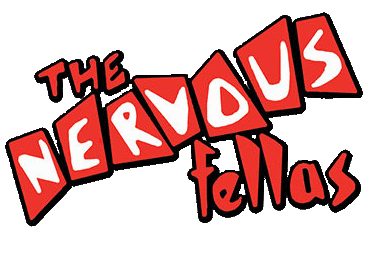Mark Twang Presents
What is Rockabilly ?
From wiki facebook.com 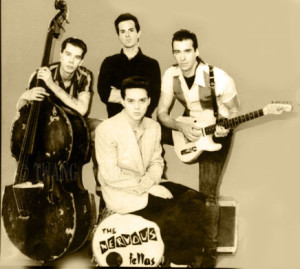 Rockabilly is one of the earliest styles of rock and roll music, dating to the early 1950s in the United States, especially the South. As a genre it blends the sound of American folk and Western musical styles, such as country and bluegrass, with that of rhythm and blues, leading to what is considered “classic” rock and roll. Some have also described it as a blend of the bluegrass style with rock and roll. The term “rockabilly” itself is a portmanteau of “rock” (from “rock ‘n’ roll”) and “hillbilly”, the latter a reference to the country music (often called “hillbilly music” in the 1940s and 1950s) that contributed strongly to the style’s development. Other important influences on rockabilly include western swing and boogie woogie. Defining features of the rockabilly sound included strong rhythms, vocal twangs and common use of the tape echo, but the progressive addition of different instruments and vocal harmonies led to its “dilution”. Initially popularised by artists such as Bill Haley, Elvis Presley, Carl Perkins and Jerry Lee Lewis, the influence and success of the style waned in the 1960s; nonetheless, during the late 1970s and early 1980s, rockabilly enjoyed a major revival through acts such as the Stray Cats. An interest in the genre endures even in the 21st century, often within a subculture. Rockabilly has left a legacy, spawning a variety of sub-styles and influencing other genres such as punk rock.
Rockabilly is one of the earliest styles of rock and roll music, dating to the early 1950s in the United States, especially the South. As a genre it blends the sound of American folk and Western musical styles, such as country and bluegrass, with that of rhythm and blues, leading to what is considered “classic” rock and roll. Some have also described it as a blend of the bluegrass style with rock and roll. The term “rockabilly” itself is a portmanteau of “rock” (from “rock ‘n’ roll”) and “hillbilly”, the latter a reference to the country music (often called “hillbilly music” in the 1940s and 1950s) that contributed strongly to the style’s development. Other important influences on rockabilly include western swing and boogie woogie. Defining features of the rockabilly sound included strong rhythms, vocal twangs and common use of the tape echo, but the progressive addition of different instruments and vocal harmonies led to its “dilution”. Initially popularised by artists such as Bill Haley, Elvis Presley, Carl Perkins and Jerry Lee Lewis, the influence and success of the style waned in the 1960s; nonetheless, during the late 1970s and early 1980s, rockabilly enjoyed a major revival through acts such as the Stray Cats. An interest in the genre endures even in the 21st century, often within a subculture. Rockabilly has left a legacy, spawning a variety of sub-styles and influencing other genres such as punk rock. 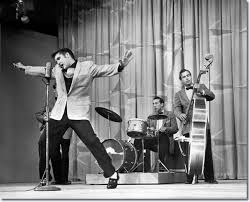 There was a close relationship between blues and country music from the very earliest country recordings in the 1920s. The first nationwide country hit was “Wreck of the Old 97”, backed with “Lonesome Road Blues”, which also became quite popular.Jimmie Rodgers, the “first true country star”, was known as the “Blue Yodeler”, and most of his songs used blues-based chord progressions, although with very different instrumentation and sound from the recordings of his black contemporaries like Blind Lemon Jefferson and Bessie Smith. During the 1930s and 1940s, two new sounds emerged. Bob Wills and his Texas Playboys were the leading proponents of Western Swing, which combined country singing and steel guitar with big band jazz influences and horn sections; Wills’s music found massive popularity. Recordings of Wills’s from the mid 1940s to the early 1950s include “two beat jazz” rhythms, “jazz choruses”, and guitar work that preceded early rockabilly recordings. Wills is quoted as saying “Rock and Roll? Why, man, that’s the same kind of music we’ve been playin’ since 1928!… But it’s just basic rhythm and has gone by a lot of different names in my time. It’s the same, whether you just follow a drum beat like in Africa or surround it with a lot of instruments. The rhythm’s what’s important.” After blues artists like Meade Lux Lewis and Pete Johnson launched a nationwide boogie craze starting in 1938, country artists like Moon Mullican, the Delmore Brothers, Tennessee Ernie Ford, Speedy West, Jimmy Bryant, and the Maddox Brothers and Rose began recording what was known as “Hillbilly Boogie”, which consisted of “hillbilly” vocals and instrumentation with a boogie bass line. The Maddox Brothers and Rose were at “the leading edge of rockabilly with the slapped bass that Fred Maddox had developed”. Maddox said, “You’ve got to have somethin’ they can tap their foot, or dance to, or to make ’em feel it.” After World War II the band shifted into higher gear leaning more toward a whimsical honky-tonk feel, with a heavy, manic bottom end – the slap bass of Fred Maddox. “They played hillbilly music but it sounded real hot. They played real loud for that time, too …” The Maddoxes were also known for their lively “antics and stuff.” “We always put on a show … I mean it just wasn’t us up there pickin’ and singing. There was something going on all the time.” “… the demonstrative Maddoxes, helped release white bodies from traditional motions of decorum… more and more younger white artists began to behave on stage like the lively Maddoxes.” Others believe that they were not only at the leading edge, but were one of the first Rockabilly groups, if not the first. Zeb Turner’s February 1953 recording of “Jersey Rock” with its mix of musical styles, lyrics about music and dancing, and guitar solo, is another example of the mixing of musical genres in the first half of the 1950s.
There was a close relationship between blues and country music from the very earliest country recordings in the 1920s. The first nationwide country hit was “Wreck of the Old 97”, backed with “Lonesome Road Blues”, which also became quite popular.Jimmie Rodgers, the “first true country star”, was known as the “Blue Yodeler”, and most of his songs used blues-based chord progressions, although with very different instrumentation and sound from the recordings of his black contemporaries like Blind Lemon Jefferson and Bessie Smith. During the 1930s and 1940s, two new sounds emerged. Bob Wills and his Texas Playboys were the leading proponents of Western Swing, which combined country singing and steel guitar with big band jazz influences and horn sections; Wills’s music found massive popularity. Recordings of Wills’s from the mid 1940s to the early 1950s include “two beat jazz” rhythms, “jazz choruses”, and guitar work that preceded early rockabilly recordings. Wills is quoted as saying “Rock and Roll? Why, man, that’s the same kind of music we’ve been playin’ since 1928!… But it’s just basic rhythm and has gone by a lot of different names in my time. It’s the same, whether you just follow a drum beat like in Africa or surround it with a lot of instruments. The rhythm’s what’s important.” After blues artists like Meade Lux Lewis and Pete Johnson launched a nationwide boogie craze starting in 1938, country artists like Moon Mullican, the Delmore Brothers, Tennessee Ernie Ford, Speedy West, Jimmy Bryant, and the Maddox Brothers and Rose began recording what was known as “Hillbilly Boogie”, which consisted of “hillbilly” vocals and instrumentation with a boogie bass line. The Maddox Brothers and Rose were at “the leading edge of rockabilly with the slapped bass that Fred Maddox had developed”. Maddox said, “You’ve got to have somethin’ they can tap their foot, or dance to, or to make ’em feel it.” After World War II the band shifted into higher gear leaning more toward a whimsical honky-tonk feel, with a heavy, manic bottom end – the slap bass of Fred Maddox. “They played hillbilly music but it sounded real hot. They played real loud for that time, too …” The Maddoxes were also known for their lively “antics and stuff.” “We always put on a show … I mean it just wasn’t us up there pickin’ and singing. There was something going on all the time.” “… the demonstrative Maddoxes, helped release white bodies from traditional motions of decorum… more and more younger white artists began to behave on stage like the lively Maddoxes.” Others believe that they were not only at the leading edge, but were one of the first Rockabilly groups, if not the first. Zeb Turner’s February 1953 recording of “Jersey Rock” with its mix of musical styles, lyrics about music and dancing, and guitar solo, is another example of the mixing of musical genres in the first half of the 1950s.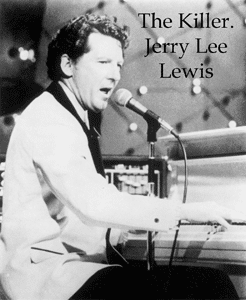 The Memphis blues musician Junior Parker and his electric blues band, Little Junior’s Blue Flames, featuring Pat Hare on the guitar, were a major influence on the rockabilly style, particularly with their songs “Love My Baby” and “Mystery Train” in 1953. Bill Monroe is known as the Father of Bluegrass, a specific style of country music. Many of his songs were in blues form, while others took the form of folk ballads, parlor songs, or waltzes. Bluegrass was a staple of country music in the early 1950s, and is often mentioned as an influence in the development of rockabilly. The Honky Tonk sound, which “tended to focus on working-class life, with frequently tragic themes of lost love, adultery, loneliness, alcoholism, and self-pity”, also included songs of energetic, uptempo Hillbilly Boogie. Some of the better known musicians who recorded and performed these songs are: the Delmore Brothers, the Maddox Brothers and Rose, Merle Travis, Hank Williams, Hank Snow, and Tennessee Ernie Ford. Curtis Gordon’s 1953 “Rompin’ and Stompin'”, an uptempo hillbilly-boogie included the lyrics, “Way down south where I was born / They rocked all night ’til early morn’ / They start rockin’ / They start rockin’ an rollin’.” Carl Perkins pictured around 1955
The Memphis blues musician Junior Parker and his electric blues band, Little Junior’s Blue Flames, featuring Pat Hare on the guitar, were a major influence on the rockabilly style, particularly with their songs “Love My Baby” and “Mystery Train” in 1953. Bill Monroe is known as the Father of Bluegrass, a specific style of country music. Many of his songs were in blues form, while others took the form of folk ballads, parlor songs, or waltzes. Bluegrass was a staple of country music in the early 1950s, and is often mentioned as an influence in the development of rockabilly. The Honky Tonk sound, which “tended to focus on working-class life, with frequently tragic themes of lost love, adultery, loneliness, alcoholism, and self-pity”, also included songs of energetic, uptempo Hillbilly Boogie. Some of the better known musicians who recorded and performed these songs are: the Delmore Brothers, the Maddox Brothers and Rose, Merle Travis, Hank Williams, Hank Snow, and Tennessee Ernie Ford. Curtis Gordon’s 1953 “Rompin’ and Stompin'”, an uptempo hillbilly-boogie included the lyrics, “Way down south where I was born / They rocked all night ’til early morn’ / They start rockin’ / They start rockin’ an rollin’.” Carl Perkins pictured around 1955 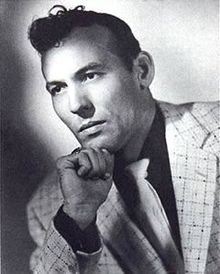 Sharecroppers’ sons Carl Perkins and his brothers Jay Perkins and Clayton Perkins, along with drummer W. S. Holland, had been playing their music roughly ninety miles from Memphis. The Perkins Brothers Band, featuring both Carl and Jay on lead vocals, quickly established themselves as the hottest band on the cutthroat, “get-hot-or-go-home” Jackson, Tennessee honky tonk circuit. Most of the requests for songs were for hillbilly songs that were delivered as jived up versions—classic Hank Williams standards infused with a faster rhythm. It was here that Carl started composing his first songs with an eye toward the future. Watching the dance floor at all times for a reaction, working out a more rhythmically driving style of music that was neither country nor blues, but had elements of both, Perkins kept reshaping these loosely structured songs until he had a completed composition, which would then be finally put to paper. Carl was already sending demos to New York record companies, who kept rejecting him, sometimes explaining that this strange new style of country with a pronounced rhythm fit no current commercial trend. That would change in 1955 after recording the song ‘Blue Suede Shoes’ (recorded 19 December 1955). Later made more famous by Elvis Presley, Perkins’ original version was an early rock ‘n’ roll standard.
Sharecroppers’ sons Carl Perkins and his brothers Jay Perkins and Clayton Perkins, along with drummer W. S. Holland, had been playing their music roughly ninety miles from Memphis. The Perkins Brothers Band, featuring both Carl and Jay on lead vocals, quickly established themselves as the hottest band on the cutthroat, “get-hot-or-go-home” Jackson, Tennessee honky tonk circuit. Most of the requests for songs were for hillbilly songs that were delivered as jived up versions—classic Hank Williams standards infused with a faster rhythm. It was here that Carl started composing his first songs with an eye toward the future. Watching the dance floor at all times for a reaction, working out a more rhythmically driving style of music that was neither country nor blues, but had elements of both, Perkins kept reshaping these loosely structured songs until he had a completed composition, which would then be finally put to paper. Carl was already sending demos to New York record companies, who kept rejecting him, sometimes explaining that this strange new style of country with a pronounced rhythm fit no current commercial trend. That would change in 1955 after recording the song ‘Blue Suede Shoes’ (recorded 19 December 1955). Later made more famous by Elvis Presley, Perkins’ original version was an early rock ‘n’ roll standard.
Memphis
In the early 1950s there was heavy competition among Memphis area bands playing an audience-savvy mix of covers, original songs, and hillbilly flavored blues. One source mentions both local disc jockey Dewey Phillips and Sam Phillips as being influential. Scotty Moore remembers that, “You could play … As long as you could play, say, the top eight or ten songs from country, pop, R&B. They didn’t care what instruments you had, as long as people could dance.”
The Saturday Night Jamboree
The Saturday Night Jamboree was a local stage show held every Saturday night at the Goodwyn Institute Auditorium in downtown Memphis, Tennessee in 1953–54. But of more historical significance were the unknown artists who came to perform at the Jamboree. They include: Elvis Presley, Johnny and Dorsey Burnette, Eddie Bond, Charlie Feathers, Jim Cannon, Reggie Young, Barbara Pittman,the Lazenby Twins, Bud Deckleman, Harmonica Frank Floyd, Marcus Van Story, Lloyd Arnold, and more. The shows were sometimes broadcast on KWEM Radio Station in West Memphis, Arkansas by Joe Manuel, who fronted the Jamboree and was a KWEM personality. Every Saturday night in 1953, the dressing rooms backstage were a gathering place where musicians would come together and experiment with new sounds—mixing fast country, gospel, blues and boogie woogie. Guys were bringing in new “licks” that they had developed and were teaching them to other musicians and were learning new “licks” from yet other musicians backstage. Soon these new sounds began to make their way out onto the stage of the Jamboree where they found a very receptive audience.
Rockabilly Trio
The Burnettes and Burlison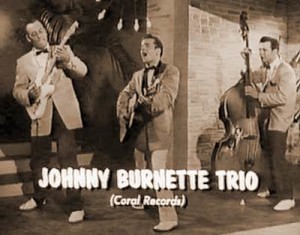 Younger musicians around Memphis, were beginning to play a mix of musical styles. Paul Burlison, for one, was playing in nondescript hillbilly bands in the very early 1950s. One of these early groups secured a fifteen-minute show on radio station KWEM in West Memphis, Arkansas. The time slot was adjacent to Howlin’ Wolf’s and the music quickly became a curious blend of blues, country and what would become known as rockabilly music. In 1951 and 1952 the Burnettes (Johnny and Dorsey) and Burlison played around Memphis and established a reputation for wild music. According to Burlison, “… when we started playing in 1951, we played an uptempo-style country beat with gospel, blues, and a little swing mixed in.” They played with Doc McQueen’s Swing Band at the Hideaway Club but hated the type of music played by “chart musicians.” Soon they broke away and began playing their energetic brand of rockabilly to small, but appreciative, local audiences. They wrote “Rock Billy Boogie,” named after Johnny’s new baby boy Rocky Burnette and Dorsey’s new son Billy, who were both born in 1953, while working at the Hideaway. Unfortunately for the Burnettes and Burlison, they did not record the song until 1957. The trio released “Train Kept A-Rollin'” in 1956, listed by Rolling Stone magazine as one of the top 500 rock songs of all time, having been covered by the Yardbirds, Aerosmith, and many others. Many consider this 1956 recording to be the first intentional use of a distortion guitar on a rock song, played by lead guitarist Paul Burlison.
Younger musicians around Memphis, were beginning to play a mix of musical styles. Paul Burlison, for one, was playing in nondescript hillbilly bands in the very early 1950s. One of these early groups secured a fifteen-minute show on radio station KWEM in West Memphis, Arkansas. The time slot was adjacent to Howlin’ Wolf’s and the music quickly became a curious blend of blues, country and what would become known as rockabilly music. In 1951 and 1952 the Burnettes (Johnny and Dorsey) and Burlison played around Memphis and established a reputation for wild music. According to Burlison, “… when we started playing in 1951, we played an uptempo-style country beat with gospel, blues, and a little swing mixed in.” They played with Doc McQueen’s Swing Band at the Hideaway Club but hated the type of music played by “chart musicians.” Soon they broke away and began playing their energetic brand of rockabilly to small, but appreciative, local audiences. They wrote “Rock Billy Boogie,” named after Johnny’s new baby boy Rocky Burnette and Dorsey’s new son Billy, who were both born in 1953, while working at the Hideaway. Unfortunately for the Burnettes and Burlison, they did not record the song until 1957. The trio released “Train Kept A-Rollin'” in 1956, listed by Rolling Stone magazine as one of the top 500 rock songs of all time, having been covered by the Yardbirds, Aerosmith, and many others. Many consider this 1956 recording to be the first intentional use of a distortion guitar on a rock song, played by lead guitarist Paul Burlison.
Elvis Presley
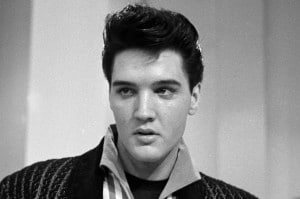 Presley’s first recording, a blues song titled “That’s Alright Mama”, was previously recorded in 1946 by Arthur Crudup. In this recording Presley married “black” and “white” genres to an extent that it was denied airplay on (white) country radio stations and (black) R&B stations, dismissed for being defined as both “black” and “white” music. Record Producer Sam Phillips was told by country deejays that Presley’s “That’s Alright Mama” was “black music” and lamented they would be “run out of town” for playing it. Similarly, R&B deejays categorized it as a (white) country song. When the song was finally played by one rogue deejay, Dewey Phillips, Presley’s recording created so much excitement it was described as having waged war on segregated radio stations. “The Sun recordings were the first salvos in an undeclared war on segregated radio stations nationwide.” All of Presley’s early records combined a blues song on one side and a country song on the other, but both sung in the same vein. Presley’s unique musical style rocketed him into the spotlight, and drew masses of followers: “But it’s Presley’s singing, halfway between a country western and a R&B rock ‘n’ roll style that has sent teenagers into a trance. Whether you like it or not, there will always be an Elvis Presley.” Presley’s first, historical recordings took place at Sun Records, a small independent label run by Sam Phillips in Memphis, Tennessee. The historical significance of these first Presley recordings and their impact on future musical artists is well exemplified by the actions of legendary musical artist Bob Dylan, who is said to have gone to Sun Records and kissed the “x” where Elvis had stood to record his first recordings. Further stated by Dylan: “I thank God for Elvis Presley”. For several years, Phillips had been recording and releasing performances by blues and country musicians in the area. He also ran a service allowing anyone to come in off the street and for $3.98 (plus tax) record himself on a two-song vanity record. One young man who came to record himself as a surprise for his mother, he claimed, was Elvis Presley. According to Phillips, “Ninety-five percent of the people I had been working with were black, most of them of course no name people. Elvis fit right in. He was born and raised in poverty. He was around people that had very little in the way of worldly goods.” Presley made enough of an impression that Phillips deputized guitarist Scotty Moore, who then enlisted bassist Bill Black, both from the Starlight Wranglers, a local western swing band, to work with the green young Elvis. The trio rehearsed dozens of songs, from traditional country, to “Harbor Lights”, a hit for crooner Bing Crosby to gospel. During a break on July 5, 1954, Elvis “jumped up … and started frailin’ guitar and singin’ “That’s All Right, Mama” (a 1946 blues song by Arthur “Big Boy” Crudup). Scotty and Bill began playing along. Excited, Phillips told them to “back up and start from the beginning.” Two or three takes later, Phillips had a satisfactory recording, and released “That’s All Right”, on July 19, 1954, along with an “Elvis Presley Scotty and Bill” version of Bill Monroe’s waltz, Blue Moon of Kentucky, a country standard. Presley’s Sun recordings feature his vocals and rhythm guitar, Bill Black’s percussive slapped bass, and Scotty Moore on an amplified guitar. Slap bass had been a staple of both Western Swing and Hillbilly Boogie since the 1940s. Commenting on his own guitar playing, Scotty Moore said, “All I can tell you is I just stole from every guitar player I heard over the years. Put it in my data bank. An’ when I played that’s just what come out.”
Presley’s first recording, a blues song titled “That’s Alright Mama”, was previously recorded in 1946 by Arthur Crudup. In this recording Presley married “black” and “white” genres to an extent that it was denied airplay on (white) country radio stations and (black) R&B stations, dismissed for being defined as both “black” and “white” music. Record Producer Sam Phillips was told by country deejays that Presley’s “That’s Alright Mama” was “black music” and lamented they would be “run out of town” for playing it. Similarly, R&B deejays categorized it as a (white) country song. When the song was finally played by one rogue deejay, Dewey Phillips, Presley’s recording created so much excitement it was described as having waged war on segregated radio stations. “The Sun recordings were the first salvos in an undeclared war on segregated radio stations nationwide.” All of Presley’s early records combined a blues song on one side and a country song on the other, but both sung in the same vein. Presley’s unique musical style rocketed him into the spotlight, and drew masses of followers: “But it’s Presley’s singing, halfway between a country western and a R&B rock ‘n’ roll style that has sent teenagers into a trance. Whether you like it or not, there will always be an Elvis Presley.” Presley’s first, historical recordings took place at Sun Records, a small independent label run by Sam Phillips in Memphis, Tennessee. The historical significance of these first Presley recordings and their impact on future musical artists is well exemplified by the actions of legendary musical artist Bob Dylan, who is said to have gone to Sun Records and kissed the “x” where Elvis had stood to record his first recordings. Further stated by Dylan: “I thank God for Elvis Presley”. For several years, Phillips had been recording and releasing performances by blues and country musicians in the area. He also ran a service allowing anyone to come in off the street and for $3.98 (plus tax) record himself on a two-song vanity record. One young man who came to record himself as a surprise for his mother, he claimed, was Elvis Presley. According to Phillips, “Ninety-five percent of the people I had been working with were black, most of them of course no name people. Elvis fit right in. He was born and raised in poverty. He was around people that had very little in the way of worldly goods.” Presley made enough of an impression that Phillips deputized guitarist Scotty Moore, who then enlisted bassist Bill Black, both from the Starlight Wranglers, a local western swing band, to work with the green young Elvis. The trio rehearsed dozens of songs, from traditional country, to “Harbor Lights”, a hit for crooner Bing Crosby to gospel. During a break on July 5, 1954, Elvis “jumped up … and started frailin’ guitar and singin’ “That’s All Right, Mama” (a 1946 blues song by Arthur “Big Boy” Crudup). Scotty and Bill began playing along. Excited, Phillips told them to “back up and start from the beginning.” Two or three takes later, Phillips had a satisfactory recording, and released “That’s All Right”, on July 19, 1954, along with an “Elvis Presley Scotty and Bill” version of Bill Monroe’s waltz, Blue Moon of Kentucky, a country standard. Presley’s Sun recordings feature his vocals and rhythm guitar, Bill Black’s percussive slapped bass, and Scotty Moore on an amplified guitar. Slap bass had been a staple of both Western Swing and Hillbilly Boogie since the 1940s. Commenting on his own guitar playing, Scotty Moore said, “All I can tell you is I just stole from every guitar player I heard over the years. Put it in my data bank. An’ when I played that’s just what come out.”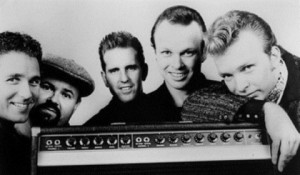 Scotty Moore described their first session, resulting in the recording of “That’s Alright Mama”: “We were taking a break and, all of sudden, Elvis started singing this song, jumping around and acting the fool. Then Bill Black picked up his bass and began acting the fool too, and I started playing with them. Sam had the door to the control room open, and stuck his head out and said, ‘What are you doing?’ We said, ‘We don’t know’. He said, ‘Well, back up. Try to find a place to start, and do it again’. So we kinda talked it over and figured out a little bit what we were doin’. We ran it again, and of course Sam is listenin’. ‘Bout the third or fourth time through, we just cut it. It was basically a rhythm record. It wasn’t any great thing. It wasn’t Sam tellin’ him what to do. Elvis was joking around, just doing what come naturally, what he felt.” Tillman Franks has been quoted as saying, “I want you to give Bill Black the credit.” On “That’s All Right (Mama)” and “Blue Moon of Kentucky” Elvis sang the way Bill Black played bass.” Some have claimed that the sound of “That’s Alright” was not entirely new, “It wasn’t that they said ‘I never heard anything like it before.’ It wasn’t as if this started a revolution, it galvanized a revolution. Not because Elvis had expressed something new, but he expressed something they had all been trying to express.” Sam Phillips indicated that for him it was a new sound, saying “It just broke me up”. And many echo the sentiment that it was a sound like no other they had heard: “When I first heard Elvis singing ‘That’s Alright Mama’. The time just stood still. It knocked my socks off.” –Ramon Maupin.
Scotty Moore described their first session, resulting in the recording of “That’s Alright Mama”: “We were taking a break and, all of sudden, Elvis started singing this song, jumping around and acting the fool. Then Bill Black picked up his bass and began acting the fool too, and I started playing with them. Sam had the door to the control room open, and stuck his head out and said, ‘What are you doing?’ We said, ‘We don’t know’. He said, ‘Well, back up. Try to find a place to start, and do it again’. So we kinda talked it over and figured out a little bit what we were doin’. We ran it again, and of course Sam is listenin’. ‘Bout the third or fourth time through, we just cut it. It was basically a rhythm record. It wasn’t any great thing. It wasn’t Sam tellin’ him what to do. Elvis was joking around, just doing what come naturally, what he felt.” Tillman Franks has been quoted as saying, “I want you to give Bill Black the credit.” On “That’s All Right (Mama)” and “Blue Moon of Kentucky” Elvis sang the way Bill Black played bass.” Some have claimed that the sound of “That’s Alright” was not entirely new, “It wasn’t that they said ‘I never heard anything like it before.’ It wasn’t as if this started a revolution, it galvanized a revolution. Not because Elvis had expressed something new, but he expressed something they had all been trying to express.” Sam Phillips indicated that for him it was a new sound, saying “It just broke me up”. And many echo the sentiment that it was a sound like no other they had heard: “When I first heard Elvis singing ‘That’s Alright Mama’. The time just stood still. It knocked my socks off.” –Ramon Maupin. 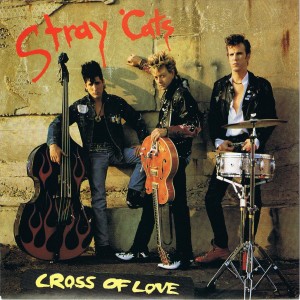 Nobody was sure what to call Presley’s music, so Elvis was described as “The Hillbilly Cat” and “King of Western Bop.” Over the next year, Elvis would record four more singles for Sun. Rockabilly recorded by artists prior to Presley can be described as being in the long-standing country style of Rockabilly. Presley’s recordings are described by some as quintessential rockabilly for their true union of country and R&B, which can be described as the true realization of the Rockabilly genre. In addition to the fusion of distinct genres, Presley’s recordings contain some traditional as well as new traits: “nervously up tempo” (as Peter Guralnick describes it), with slap bass, fancy guitar picking, lots of echo, shouts of encouragement, and vocals full of histrionics such as hiccups, stutters, and swoops from falsetto to bass and back again. By end of 1954 Elvis asked D.J. Fontana, who was the underutilized drummer for the Louisiana Hayride, “Would you go with us if we got any more dates?” Presley was now using drums, as did many other rockabilly performers; drums were then uncommon in country music. In the 1955 sessions shortly after Presley’s move from Sun Records to RCA, Presley was backed by a band that included Moore, Black, Fontana, lap steel guitarist Jimmy Day, and pianist Floyd Cramer. In 1956 Elvis acquired vocal backup via the Jordanaires. North of the Mason-Dixon Line
Nobody was sure what to call Presley’s music, so Elvis was described as “The Hillbilly Cat” and “King of Western Bop.” Over the next year, Elvis would record four more singles for Sun. Rockabilly recorded by artists prior to Presley can be described as being in the long-standing country style of Rockabilly. Presley’s recordings are described by some as quintessential rockabilly for their true union of country and R&B, which can be described as the true realization of the Rockabilly genre. In addition to the fusion of distinct genres, Presley’s recordings contain some traditional as well as new traits: “nervously up tempo” (as Peter Guralnick describes it), with slap bass, fancy guitar picking, lots of echo, shouts of encouragement, and vocals full of histrionics such as hiccups, stutters, and swoops from falsetto to bass and back again. By end of 1954 Elvis asked D.J. Fontana, who was the underutilized drummer for the Louisiana Hayride, “Would you go with us if we got any more dates?” Presley was now using drums, as did many other rockabilly performers; drums were then uncommon in country music. In the 1955 sessions shortly after Presley’s move from Sun Records to RCA, Presley was backed by a band that included Moore, Black, Fontana, lap steel guitarist Jimmy Day, and pianist Floyd Cramer. In 1956 Elvis acquired vocal backup via the Jordanaires. North of the Mason-Dixon Line
Bill Haley and His Comets during a TV appearance.
In 1951 a western swing bandleader named Bill Haley recorded a version of “Rocket 88” with his group, the Saddlemen. It is considered one of the earliest recognized rockabilly recordings. Haley and his band mates crafted a rockabilly sound during this period as the Saddlemen. It was followed by versions of “Rock the Joint” in 1952, and original works such as “Real Rock Drive” and “Crazy Man, Crazy”, the latter of which reached #12 on the American Billboard chart in 1953. On April 12, 1954, Haley with his band (now known as Bill Haley and His Comets) recorded “Rock Around the Clock” for Decca Records of New York City. When first released in May 1954, “Rock Around the Clock” made the charts for one week at number 23, and sold 75,000 copies. A year later it was featured in the film Blackboard Jungle, and soon afterwards it was topping charts all over the world and opening up a new genre of entertainment. “Rock Around the Clock” hit No. 1, held that position for eight weeks, and was the #2 song on the Billboard Hot 100 chart for 1955. The recording was, until the late 1990s, recognized by Guinness World Records as having the highest sales claim for a pop vinyl recording, with an “unaudited” claim of 25 million copies sold. Rock ‘n’ roll, an expansive term coined a couple years earlier by DJ Alan Freed, had now been to the pop mountaintop, a position it would never quite relinquish.
Bill Flagg
Maine native, and Connecticut resident Bill Flagg began using the term rockabilly for his combination of rock ‘n’ roll and hillbilly music as early as 1953 He cut several songs for Tetra Records in 1956 and 1957. “Go Cat Go” went into the National Billboard charts in 1956, and his “Guitar Rock” is cited as classic rockabilly.
Janis Martin on The Old Dominion Barn Dance Show
In 1953 at the age of 13 Janis Martin was developing her own proto-rockabilly style on WRVA’s Old Dominion Barn Dance, which broadcast out of Richmond, VA. Although Martin performed mostly country songs for the show, she also did songs by Rhythm and blues singers Ruth Brown and LaVern Baker, as well as a few Dinah Washington songs. “The audience didn’t know what to make of it. They didn’t hardly allow electric instruments, and I was doing some songs by black artists—stuff like Ruth Brown’s “(Mama) He Treats Your Daughter Mean.”
Cash, Perkins, and Presley
In 1954, both Johnny Cash and Carl Perkins auditioned for Sam Phillips. Cash hoped to record gospel music, but Phillips immediately nixed that idea. Cash did not return until 1955. In October 1954 Carl Perkins and “The Perkins Brothers Band” showed up at the Sun Studios. Phillips recorded Perkins’s original song Movie Magg, which was released early March 1955 on Phillips’s Flip label, which was all country. Presley’s second and third records were not as successful as the first. The fourth release in May 1955 Baby, Let’s Play House peaked at #5 on the national Billboard Country Chart. The Sun label correctly lists “Gunter” (Arthur) as the song writer, a song which he recorded in 1954. In 1951 Eddy Arnold recorded a song titled I Want to Play House with You by Cy Coben that sounds nothing like the Arthur Gunter song recorded by Elvis. Cash returned to Sun in 1955 with his song Hey, Porter, and his group the Tennessee Three, who became the Tennessee Two before the session was over. This song and another Cash original, Cry! Cry! Cry! were released in July.Cry! Cry! Cry! managed to crack Billboard’s Top 20, peaking at No. 14. In August Sun released Elvis’s versions of “I Forgot to Remember to Forget” and “Mystery Train”. “Forgot …”, written by Sun country artists Stan Kesler and Charlie Feathers, spent a total of 39 weeks on the Billboard Country Chart, with five of the those weeks at the #1 spot. “Mystery Train”, with writing credits for both Herman Little Junior Parker and Sam Phillips, peaked at #11. Through most of 1955, Cash, Perkins, Presley, and other Louisiana Hayride performers toured through Texas, Arkansas, Oklahoma, Louisiana and Mississippi. Sun released two more Perkins songs in October: “Gone, Gone, Gone” and “Let the Jukebox Keep on Playing”. Scotty Moore commented on the different roles of Elvis and Perkins, “Carl was a nice-looking big hunk, like out in the cornfield type. Elvis was more like an Adonis. But as a rockabilly, Carl was the king of that.” 1955 was also the year in which Chuck Berry’s hillbilly-influenced Maybellene reached high in the charts as a crossover hit, and Bill Haley and His Comets’ Rock Around the Clock was not only #1 for 8 weeks, but was the #2 record for the year. Rock ‘n’ Roll in general, and rockabilly in particular, was at critical mass and the next year, Elvis Presley’s Heartbreak Hotel and Don’t Be Cruel would top the Billboard Charts as well.
Rockabilly goes national: 1956
In January 1956 three new classic songs by Cash, Perkins, and Presley were released: “Folsom Prison Blues” by Cash, and “Blue Suede Shoes” by Perkins, both on Sun; and “Heartbreak Hotel” by Presley on RCA. Other rockabilly tunes released this month included See You Later Alligator by Roy Hall and Whole Lotta Shakin’ Goin’ On by the Commodores (no relation to the ’70s Motown group). Perkins’s “Blue Suede Shoes” sold 20,000 records a day at one point, and it was the first million-selling country song to cross over to both rhythm and blues and pop charts. On February 11, Presley appeared on the Dorsey Brothers’ Stage Show for the third time, singing “Blue Suede Shoes” and “Heartbreak Hotel.” He performed “Blue Suede Shoes” two more times on national television, and “Heartbreak Hotel” three times throughout 1956. Both songs topped the Billboard charts. Perkins first performed “Blue Suede Shoes” on television March 17 on Ozark Jubilee, a weekly ABC-TV program. From 1955 to 1960, the live national radio and TV show from Springfield, Missouri featured Brenda Lee and Wanda Jackson and guests included Gene Vincent and other rockabilly artists. Sun and RCA weren’t the only record companies releasing rockabilly music. In March Columbia released “Honky Tonk Man” by Johnny Horton, King put out “Seven Nights to Rock” by Moon Mullican, Mercury issued “Rockin’ Daddy” by Eddie Bond, and Starday released Bill Mack’s “Fat Woman”. Carl Perkins, meanwhile, was involved in a major automobile accident on his way to appear on national television. Two young men from Texas made their record debuts in April 1956: Buddy Holly on the Decca label, and, as a member of the Teen Kings, Roy Orbison with “Ooby Dooby” on the New Mexico/Texas based Je-wel label. Holly’s big hits would not be released until 1957. Janis Martin was all of fifteen years old when RCA issued a record with “Will You, Willyum” and the Martin composed “Drugstore Rock ‘n’ Roll”, which sold over 750,000 copies. King records issued a new disk by forty-seven-year-old Moon Mullican: “Seven Nights to Rock” and “Rock ‘N’ Roll Mr. Bullfrog”. Twenty more sides were issued by various labels including 4 Star, Blue Hen, Dot, Cold Bond, Mercury, Reject, Republic, Rodeo, and Starday. In April and May 1956, The Rock and Roll Trio played on the Ted Mack’s TV talent show in New York City. They won all three times and guaranteed them a finalist position in the September supershow. Gene Vincent and His Blue Caps’ recording of “Be-Bop-A-Lula” was released on June 2, 1956, backed by “Woman Love.” Within twenty-one days it sold over two hundred thousand records, stayed at the top of national pop and country charts for twenty weeks, and sold more than a million copies. These same musicians would have two more releases in 1956, followed by another in January 1957. “Queen of Rockabilly” Wanda Jackson’s first record came out in July, “I Gotta Know” on the Capitol label; followed by “Hot Dog That Made Him Mad” in November. Capitol would release nine more records by Jackson, some with songs she had written herself, before the 1950s were over. The first record by Jerry Lee Lewis came out on December 22, 1956, and it featured the song “Crazy Arms” which had been a #1 hit for Ray Price for twenty weeks earlier in the year, along with “End of the Road”. Lewis would have big hits in 1957 with his version of Whole Lot Of Shakin’ Going On, issued in May, and “Great Balls Of Fire” on Sun. 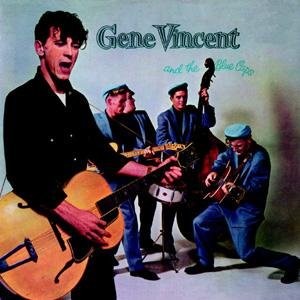 Additional performers and information There were thousands of musicians who recorded songs in the rockabilly style. An online database lists 262 musicians with names beginning with “A”. And many record companies released rockabilly records. Some enjoyed major chart success and were important influences on future rock musicians. Sun also hosted performers, such as Billy Lee Riley, Sonny Burgess, Charlie Feathers, and Warren Smith. There were also several female performers like Wanda Jackson who recorded rockabilly music long after the other ladies, Janis Martin, the female Elvis Jo Ann Campbell, and Alis Lesley, who also sang in the rockabilly style. Mel Kimbrough -“Slim”, recorded “I Get Lonesome Too” and “Ha Ha, Hey Hey” for Glenn Records along with “Love in West Virginia” and “Country Rock Sound” for Checkmate a division of Caprice Records. Gene Summers, a Dallas native and Rockabilly Hall of Fame inductee, released his classic Jan/Jane 45s in 1958-59. He continued to record rockabilly music well into 1964 with the release of “Alabama Shake”. In 2005, Summers’ most popular recording, School of Rock ‘n Roll, was selected by Bob Solly and Record Collector Magazine as one of the “100 Greatest Rock ‘n’ Roll Records”. Tommy Sleepy LaBeef (LaBeff) recorded rockabilly tunes on a number of labels from 1957 through 1963. Rockabilly pioneers the Maddox Brothers and Rose, both as a group, and with Rose as a solo act, added onto their two decades of performing by making records that were even more rocking. However, none of these artists had any major hits and their influence would not be felt until decades later In the summer of 1958 Eddie Cochran had a chart-topping hit with “Summertime Blues”. Cochran’s brief career included only a few more hits, such as “Sitting in the Balcony” released in early 1957, “C’mon Everybody” released in October 1958, and “Somethin’ Else” released in July 1959. Then in April 1960, while touring with Gene Vincent in the UK, their taxi crashed into a concrete lamp post, killing Eddie at the young age of 21. The grim coincidence in this all was that his posthumous UK number-one hit was called “Three Steps to Heaven”. For the 1957 popular song, see Rock-a-Billy (song). Rockabilly music enjoyed great popularity in the United States during 1956 and 1957, but radio play declined after 1960. Factors contributing to this decline are usually cited as: The 1959 death of Buddy Holly {along with Ritchie Valens and the Big Bopper}, the induction of Elvis Presley into the army in 1958, and a general change in American musical tastes. The style remained popular longer in England, where it attracted a fanatical following right up through the mid-1960s. Rockabilly music cultivated an attitude that assured its enduring appeal to teenagers. This was a combination of rebellion, sexuality, and freedom—a sneering expression of disdain for the workaday world of parents and authority figures. It was the first rock ‘n’ roll style to be performed primarily by white musicians, thus setting off a cultural revolution that is still reverberating today. “Rockabilly” deviance from social norms, however, was more symbolic than real; and eventual public professions of faith by aging rockabillies were not uncommon. As late as 1980, rockabilly still made it to the top of the charts with Queen’s single “Crazy Little Thing Called Love”, the song considered as a mark of Freddie Mercury’s admiration of Elvis’s music.
Additional performers and information There were thousands of musicians who recorded songs in the rockabilly style. An online database lists 262 musicians with names beginning with “A”. And many record companies released rockabilly records. Some enjoyed major chart success and were important influences on future rock musicians. Sun also hosted performers, such as Billy Lee Riley, Sonny Burgess, Charlie Feathers, and Warren Smith. There were also several female performers like Wanda Jackson who recorded rockabilly music long after the other ladies, Janis Martin, the female Elvis Jo Ann Campbell, and Alis Lesley, who also sang in the rockabilly style. Mel Kimbrough -“Slim”, recorded “I Get Lonesome Too” and “Ha Ha, Hey Hey” for Glenn Records along with “Love in West Virginia” and “Country Rock Sound” for Checkmate a division of Caprice Records. Gene Summers, a Dallas native and Rockabilly Hall of Fame inductee, released his classic Jan/Jane 45s in 1958-59. He continued to record rockabilly music well into 1964 with the release of “Alabama Shake”. In 2005, Summers’ most popular recording, School of Rock ‘n Roll, was selected by Bob Solly and Record Collector Magazine as one of the “100 Greatest Rock ‘n’ Roll Records”. Tommy Sleepy LaBeef (LaBeff) recorded rockabilly tunes on a number of labels from 1957 through 1963. Rockabilly pioneers the Maddox Brothers and Rose, both as a group, and with Rose as a solo act, added onto their two decades of performing by making records that were even more rocking. However, none of these artists had any major hits and their influence would not be felt until decades later In the summer of 1958 Eddie Cochran had a chart-topping hit with “Summertime Blues”. Cochran’s brief career included only a few more hits, such as “Sitting in the Balcony” released in early 1957, “C’mon Everybody” released in October 1958, and “Somethin’ Else” released in July 1959. Then in April 1960, while touring with Gene Vincent in the UK, their taxi crashed into a concrete lamp post, killing Eddie at the young age of 21. The grim coincidence in this all was that his posthumous UK number-one hit was called “Three Steps to Heaven”. For the 1957 popular song, see Rock-a-Billy (song). Rockabilly music enjoyed great popularity in the United States during 1956 and 1957, but radio play declined after 1960. Factors contributing to this decline are usually cited as: The 1959 death of Buddy Holly {along with Ritchie Valens and the Big Bopper}, the induction of Elvis Presley into the army in 1958, and a general change in American musical tastes. The style remained popular longer in England, where it attracted a fanatical following right up through the mid-1960s. Rockabilly music cultivated an attitude that assured its enduring appeal to teenagers. This was a combination of rebellion, sexuality, and freedom—a sneering expression of disdain for the workaday world of parents and authority figures. It was the first rock ‘n’ roll style to be performed primarily by white musicians, thus setting off a cultural revolution that is still reverberating today. “Rockabilly” deviance from social norms, however, was more symbolic than real; and eventual public professions of faith by aging rockabillies were not uncommon. As late as 1980, rockabilly still made it to the top of the charts with Queen’s single “Crazy Little Thing Called Love”, the song considered as a mark of Freddie Mercury’s admiration of Elvis’s music.
